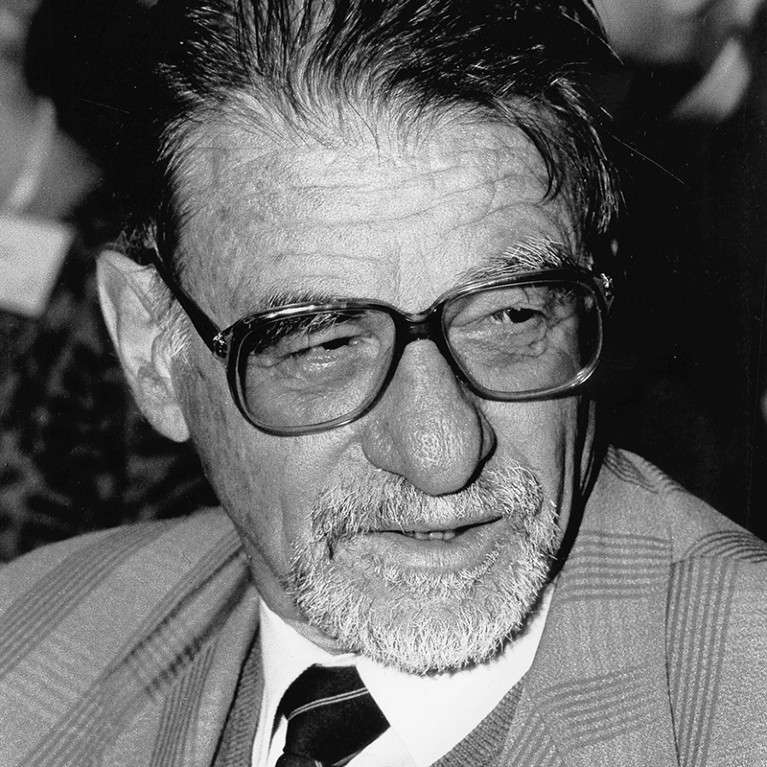
Credit: Sueddeutsche Zeitung Photo/Alamy
In 1986, Alexander Müller and his student Georg Bednorz discovered high-temperature (high-Tc) superconductivity. Only a year later, their discovery earned them the 1987 Nobel Prize in Physics. Superconductivity, in which all electrical resistance disappears below a critical temperature, had been known since 1911, but mainly in metals and alloys cooled to within a degree or two of absolute zero. Müller, who has died aged 95, demonstrated the transition to superconductivity at a temperature of 35 K (35 °C above absolute zero) in a class of ceramic known as cuprates, raising the tantalizing possibility of frictionless power distribution, levitating trains and other applications.
The physics world, initially sceptical, was gripped by excitement. At the American Physical Society’s March 1987 meeting, later dubbed the ‘Woodstock of physics’, in reference to the 1969 music festival, more than 2,000 physicists crammed into a hotel ballroom to hear a panel discuss the new superconductors. By this time, others had found related materials with transition temperatures close to 100 K. High-Tc superconductivity has since been used in magnetic resonance imaging systems and in other specialized applications — yet theorists continue to seek a satisfactory explanation for how it works.
First room-temperature superconductor excites — and baffles — scientists
Born in Basel, Switzerland, in 1927, Müller caught the science bug in childhood, when his mother gave him a vacuum-tube radio kit. At the Swiss Federal Institute of Technology in Zurich, he attended seminars given by the Nobel-prizewinning theoretical physicist Wolfgang Pauli. For his doctoral thesis under Georg Busch, he used electron paramagnetic resonance spectroscopy to study the electrical and magnetic properties of a variety of solids.
In 1958, Müller moved to the Geneva branch of the Battelle Institute, a non-profit industrial research and development organization headquartered in Columbus, Ohio. He studied radiation damage in graphite, in response to the 1957 accident at the Windscale nuclear reactor in the United Kingdom. Partly owing to damage in its graphite moderator, the reactor had overheated and caught fire, releasing a radioactive plume across Europe. Müller’s work on neutron-irradiated graphite, published in Physical Review in 1961 (K. A. Müller Phys. Rev. 123, 1550–1552; 1961), caught the attention of the director of IBM Research Zurich in Rüschlikon. He lured Müller away from Geneva in 1963 to work on solid-state problems relevant to IBM’s investment in digital computing.
Müller spent the rest of his career at IBM Rüschlikon. He established himself as a world-leading expert on perovskites — oxides with a distinctive, symmetrical crystal structure that makes them suitable for a wide range of engineering applications, including microelectronics and solar cells.
High-temperature superconductivity at 25: Still in suspense
Müller took a parallel appointment as a professor at the University of Zurich in 1970, and became director of the physics division at IBM Rüschlikon in 1973. During a two-year secondment to IBM’s Thomas J. Watson Research Center in Yorktown Heights, New York, in 1978, he seized on superconductivity as a promising research area — made more tractable by emerging work in critical phenomena, such as phase transitions. After his return to Zurich, he was named an IBM Fellow and given freedom to pursue independent research. He took up high-Tc superconductivity in earnest, and, in 1983, began his collaboration with Bednorz, who shared his fascination with perovskites.
The pair began looking for superconductivity in perovskite-like ceramics, driven by theoretical and experimental hints, but also, as Müller recalled, by an “atavistic type of feeling” of their suitability. In 1986, they observed superconductivity in lanthanum barium copper oxide with a transition temperature of around 35 K, more than 10 K above the previous highest transition temperature.
Cuprates and other high-Tc superconductors are more difficult to work with than are metal alloy low-Tc superconductors, and they have few practical applications as yet. They also do not obey the Bardeen–Cooper–Schrieffer theory, which describes how electrons interact with phonons (packets of vibrational energy) in conventional superconductors. Candidate theories emerged swiftly after 1986, but today high-Tc superconductivity remains perhaps the most notable unsolved problem in condensed-matter theory.
Superconductivity two decades on
Already aged 60 when he received the Nobel prize, Müller continued his work on superconductivity, as an IBM fellow until 1992 and at the University of Zurich until 1994, when he was awarded emeritus status. His research, which he carried on well into his eighties, shed further light on the behaviour of high-Tc superconductors, and placed major constraints on candidate theories of the phenomenon.
Müller’s approach to science reflected the expedience of industry, where the distinction between basic and applied research holds little sway. He drew ideas from anywhere he could find them, and quickly abandoned approaches that he found too constraining. He was equally happy to take inspiration from unconventional sources. He recalled being drawn to perovskites because their symmetrical structure reminded him of the mandalas of Eastern religions, to which he attributed a deep, almost spiritual significance.
Alex was an avid sportsman who skied into his eighties and preferred the slopes to the spotlight. Like his nine-year-old self building the radio, he approached physics with the attitude that he had to find out for himself. He flouted conventions that cast doubt on his instincts about superconductivity, declaring, “I just don’t talk to the theoreticians. They just held me back.” The fruits of his curiosity continue to define a significant area of condensed-matter physics and its applications.

 First room-temperature superconductor excites — and baffles — scientists
First room-temperature superconductor excites — and baffles — scientists
 High-temperature superconductivity at 25: Still in suspense
High-temperature superconductivity at 25: Still in suspense
 Superconductivity two decades on
Superconductivity two decades on
 Stunning room-temperature-superconductor claim is retracted
Stunning room-temperature-superconductor claim is retracted








